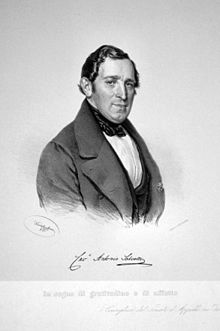Antonio Salvotti

Antonio Salvotti (born November 10, 1789 in Mori , † August 17, 1866 in Trento ) was an Austrian judge.
Life
The Catholic Salvotti came from a middle-class family and was the only one of three sons to study. He attended the University of Innsbruck in 1807 and in 1808 went to Friedrich Carl von Savigny at the University of Landshut . After completing his law degree in Bavaria , he became a lawyer in Trient in 1810. Until 1813 the monarchist Salvotti in the department of Oberetsch was a citizen of the Kingdom of Italy and then a subject of the Emperor of Austria . In 1814 he became a member of the Trento Court of Justice. In 1819 Salvotti was the Austrian examining magistrate in the so-called Carbonari trials. First of all, the emperor ordered him to Venice to deal with this matter . Salvotti became the inquirent in the trial against Pellico and Maroncelli .
In Venice he married the painter Anna Fratnich, born in 1790; Daughter of the President of the Court of Appeal .
When there was no progress in the trial of Count Confalonieri in Milan in 1821 , the Emperor sent Salvotti to the Lombard metropolis. In Milan he became a councilor of appeal.
In 1824 Salvotti went to Verona and one year later became a councilor to the Senate . In 1846 he became Baron von Eichenkraft and Bindeburg. In the same year Salvotti was transferred to Innsbruck and in 1849 to Trento. Under Ferdinand I , he was appointed to the Reichsrat in Vienna in 1851 and worked on legislation.
As early as 1825, Salvotti had campaigned in vain to publicize the judicial process.
The marriage with Anna Fratnich had two sons. The first died in childhood and the second - Scipio (1830–1883), doctor and writer - was sentenced as a conspirator against Austria to ten years for the fortress, which he served in Theresienstadt . Anna died in 1837. The widower Salvotti did not marry a second time. The pensioner spent the last years from 1861 at home in Mori.
Quotes
-
Bettine von Arnim : Goethe's correspondence with a child. Part two :
- Bettine on October 21, 1809 from Landshut: “Salvotti, a young Italian whom Savigny distinguishes very much, has beautiful eyes, but I would rather see him walking in front of me than in his face; for he wears a green cloak to which he gives an excellent drapery, beauty gives spirit to every movement; he is homesick, and although he filters his fatherland wine through the Bavarian river sand every day to get used to, he becomes paler, slimmer, more interesting every day, and soon he will have to go to his homeland to admit his secret love for her; nature has such strange crickets, tender, but not the same everywhere, the same. "
- Bettine on May 20, 1810 from Vienna: "... the Italian Salvotti, beautiful in a wide green coat, who throws the noblest folds around his solid figure, indestructible calm in his movements, glowing agility in expression, doesn’t allow himself a clever word speak to him, he is so deeply absorbed in learning. "
literature
- Constantin von Wurzbach : Salvotti von Eichenkraft and Bindeburg, Anton Freiherr . In: Biographisches Lexikon des Kaiserthums Oesterreich . 28th part. Imperial-Royal Court and State Printing Office, Vienna 1874, pp. 159–162 ( digitized version ).
- Karl Heinrich Hugelmann : Salvotti, Anton von . In: Allgemeine Deutsche Biographie (ADB). Volume 31, Duncker & Humblot, Leipzig 1890, pp. 772-779.
- Mario Menghini in the Enciclopedia Italiana (1936): Salvotti at treccani.it (Italian).
- Ricarda Huch : Antonio Salvotti . Pp. 135–163 in: People and Fates from the Risorgimento . With an afterword and comments by Günter Adler. 276 pages. Insel, Leipzig 1978.
- M. Laich: Salvotti von Eichenkraft and Bindeburg, Anton Frh .. In: Österreichisches Biographisches Lexikon 1815–1950 (ÖBL). Volume 9, Verlag der Österreichischen Akademie der Wissenschaften, Vienna 1988, ISBN 3-7001-1483-4 , p. 398 f. (Direct links on p. 398 , p. 399 ).
- Wolfgang Bunzel (Hrsg.), Ulrike Landfester (Hrsg.): Bettina von Arnim, Friedmund von Arnim: All in agreement with Dir. Bettine von Arnim's correspondence with her son . Wallstein Verlag, Göttingen 2001, ISBN 978-3-89244-240-0 .
Web links
- Alessandro Luzio: Antonio Salvotti ei processi del Ventuno Entry in HathiTrust (Italian)
- Fabrizio Rasera in 2008 at questotrentino.it: Antonio Salvotti (Italian)
- Entry in the Enciclopedie on line Salvòtti von Einchenkraft and Bindeburg, Antonio, barone (Italian)
- April 10, 1997: Maria Cristina Tosana at tiscalinet.it: Salvotti, perfido austriacante o solo esecutore di leggi? (Italian: Was Salvotti a perfidious Austrian or just one of the law enforcers?)
Remarks
- ↑ Ricarda Huch writes about Salvotti in the Milanese years: "His colleagues, to whom he was imposed by the emperor, ... like to let Salvotti know their opinion that he was building something insignificant." (Huch, p. 152, 2nd Zvu)
- ↑ The article was written on the basis of Antonio Salvotti (Italian).
- ^ Bettine von Arnim was Friedrich Carl von Savigny's sister-in-law.
- ^ Salvotti saw Bettine again in Germany in 1847.
Individual evidence
- ↑ Salvotti mentioned twice ( Zeno.org )
- ^ Italian Alessandro Luzio
| personal data | |
|---|---|
| SURNAME | Salvotti, Antonio |
| ALTERNATIVE NAMES | Salvotti von Eichenkraft and Bindeburg, Anton |
| BRIEF DESCRIPTION | Austrian judge |
| DATE OF BIRTH | November 10, 1789 |
| PLACE OF BIRTH | Mori |
| DATE OF DEATH | 17th August 1866 |
| Place of death | Trent |